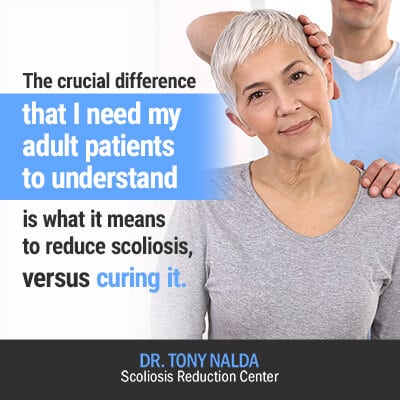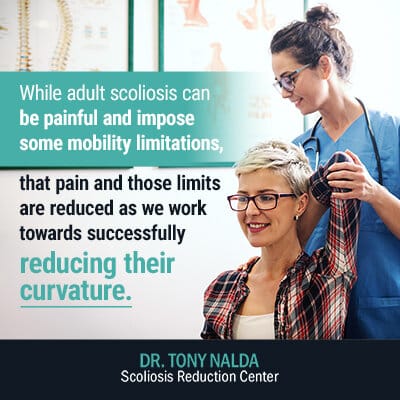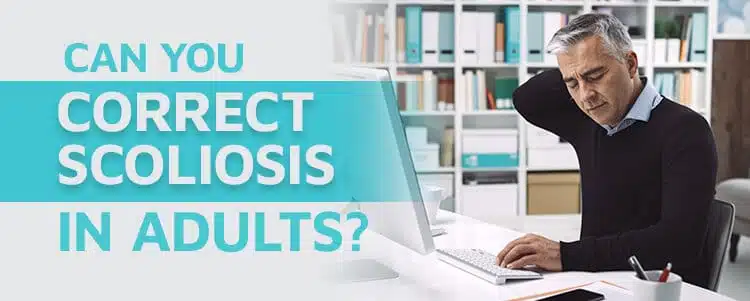When people ask if a condition can be ‘corrected’, what they most often mean is ‘cured’, or reversed permanently. While scoliosis can be reduced and managed to the point where it causes very few, if any, functional deficits, as a progressive and incurable condition, scoliosis cannot be cured.
When I diagnose a patient with scoliosis, one of the first questions they ask is if it’s curable. It’s difficult to explain that as a progressive condition, it’s going to be a factor throughout their lives, and if left untreated, it’s almost guaranteed to get worse. That sounds pretty bleak, but the good news is that with proactive treatment, it doesn’t have to limit a person’s life. So let’s start by discussing the difference between a cure and a reduction.
Curing vs. Reducing Scoliosis in Adults
When a patient wants to know if their scoliosis is curable, what they are asking is if there’s a form of treatment that can permanently reverse its effects or remove the condition from their bodies.
They are also wanting to know how bad scoliosis can get. I’ve seen all ranges of the condition from mild to severe. The smallest a curve can be to be officially diagnosed as scoliosis, assuming it also has rotation, is 10 degrees, and the largest curvature I’ve treated is 155 degrees; that’s a big range. Clearly, scoliosis can get pretty bad, if left untreated.
That being said, I’ve also seen cases of severe scoliosis that don’t come with any functional deficits; in these types of cases, often the patient’s body has simply adjusted to the curvature and functions quite normally.
I have, however, also seen the opposite end of that spectrum where patients, especially adult patients, are suffering from a lot of pain and a significant loss of flexibility in their spine.

Regardless of what an adult patient is experiencing at the time they come in to see me, if they don’t engage in active treatment, their curve is likely to progress at a faster rate as they get older. As curves get larger, they are more likely to cause a number of complications, such as radiating pain, postural effects, and compromised organ functionality.
The crucial difference that I need my adult patients to understand is what it means to reduce scoliosis, versus curing it. There is quite simply no cure for scoliosis; it’s an incurable progressive condition, meaning its very nature is to get worse.
While the rates of progression can vary from glacial to rapid, most adults will start their scoliosis journey with a slower rate that increases with age. While we can’t completely eliminate the condition, we can control and slow that progression by reducing the curve and limiting its effects on a person’s health.
Next, let’s talk about the actual process of reducing that curve and limiting its effects.
Reducing a Scoliosis Curve in Adults
When it comes to the actual process of reducing a curve, the steps are the same for adult patients as they are for adolescents and children, but the process differs in proportion.
While we might use the same disciplinary approaches for reducing curves in adolescents and adults, the ratios of the combined components would vary.
Where this mainly comes into play is in facilitating more flexibility in the spine prior to stabilizing the scoliosis. In adults, we have to induce more flexibility into their spine as the first step on the treatment path; in children and adolescents, most still have relatively flexible spines, so this step is less crucial.
Adults with scoliosis tend to lose a lot of their spinal flexibility, and the larger a curvature is, or the longer it’s left untreated, the more rigid the spine tends to be.
Many of my adult patients have only recently learned they have been living with scoliosis for years. It’s not until their condition starts to become symptomatic that they seek out help and are officially diagnosed. In these types of cases, my treatment goal is to reduce their curvature as much as possible, and at the very least, to where it was before they started experiencing pain or mobility limitations.
Next, let’s move on to what the actual process of reducing an adult patient’s scoliosis can look like.
Components of Curvature Reduction
Here at the Scoliosis Reduction Center®, our approach is to initiate treatment as close to the time of diagnosis as possible; this is to ensure we are starting our treatment when the condition is in its mildest form as this increases our chances of successfully achieving a curvature reduction. When it comes to adult scoliosis, this isn’t always possible.
As each and every condition has its own unique set of characteristics, we customize every treatment plan to best respond to the patient’s condition severity and any related symptoms or complications.
Most often, the actual components of our approach would include in-office therapy, exercise, bracing, and scoliosis-specific chiropractic adjustments.
With adults, the initial work to increase flexibility in the spine would be more intense than in our younger patients. For example, these treatment components would be quite spread out in adolescents and children, but adults would likely need a higher percentage of mobility work prior to moving on to stabilization.
So while the tools and the formula for treatment we use would be the same for younger and older patients, we would appropriate those components differently, and that is how we work towards reducing a scoliosis curve in adults.
Our approach is to treat the whole patient, and this means addressing any and all areas of a patient’s life that are affected by their condition. We don’t just want to address one aspect of the condition; we want to ensure that each and every patient can reach their full potential throughout treatment and beyond.
Living with Scoliosis

Patients of any age who choose to commit to our proactive alternative approach to scoliosis treatment can continue on to live their best lives. While it might not be curable, patients willing to do some hard work and engage actively in their treatment benefit from our ability to restore flexibility and functionality in their spine.
While adult scoliosis can be painful and impose some mobility limitations, that pain and those limits are reduced as we work towards successfully reducing their curvature. First and foremost, we address the structural issue of the curvature; next, we move on to stabilizing/supporting the spine and educating our patients on how to sustain those results.
Surely, you’ve heard of Usain Bolt – the world’s fastest man. People are often shocked to learn that he achieved that status with scoliosis. He didn’t let his condition slow him down or place limitations on his life, and you don’t have to either.
Whatever your passions are at any age, living with scoliosis doesn’t mean having to forego them; it just means adjusting that vision to include effective treatment and sustaining those results.
Together, we can design a treatment plan capable of reducing your curvature and limiting its effects on your life and overall health.
Conclusion
When scoliosis develops in adults, it’s most often a case of adolescent scoliosis progressing into adulthood without being diagnosed. Most often, it’s pain that brings adults in to see me as their scoliosis has progressed in severity.
Very often, children and adolescents with the condition experience it without pain and noticeable symptoms, which is why early diagnosis can be such a challenge.
When a person with scoliosis reaches skeletal maturity, they are no longer growing, and now their spine and its surrounding muscles and nerves are vulnerable to the compressive forces of their deformity.
While treatment started when a patient is younger and their spine is more malleable is beneficial, adults also benefit from our active treatment approach: a curvature reduction that restores function and reduces the curve to where it was before becoming symptomatic.




